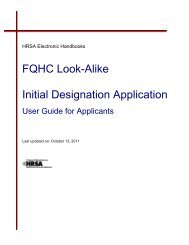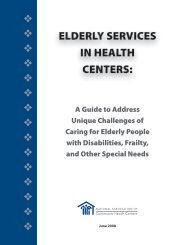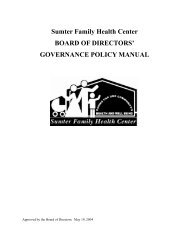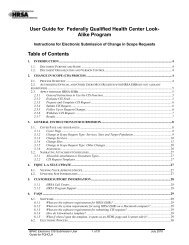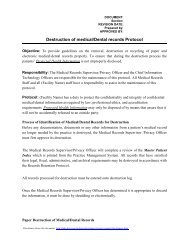(NACMH) For The - Bureau of Primary Health Care - HRSA
(NACMH) For The - Bureau of Primary Health Care - HRSA
(NACMH) For The - Bureau of Primary Health Care - HRSA
Create successful ePaper yourself
Turn your PDF publications into a flip-book with our unique Google optimized e-Paper software.
NATIONAL ADVISORY COUNCIL ON MIGRANT HEALTH (<strong>NACMH</strong>)for the Secretary <strong>of</strong> <strong>Health</strong> and Human ServicesCouncil Members in AttendanceAndrea Weathers, MD, DrPH (Chair)Jose L. Lopez (Vice Chair)Frances R. CanalesCarolyn Davis, FNPJose Manuel GaytanGwendolyn E. GouldJames Laughlin, MPHRosa MartinDora MejiaZetti D. Page, III, MD, PhDJesus A. TijerinaWenceslao VasquezNovember 8-9, 2011Albuquerque, NMFederal StaffCDR Sonsy Fermin, LCSW, Chief, <strong>Health</strong> Services Branch, Office <strong>of</strong> Special Population <strong>Health</strong>,<strong>Bureau</strong> <strong>of</strong> <strong>Primary</strong> <strong>Health</strong> <strong>Care</strong>, <strong>Health</strong> Resources and Services Administration, U.S.Department <strong>of</strong> <strong>Health</strong> and Human ServicesGladys Cate, Project Officer, <strong>Health</strong> Services Branch, Office <strong>of</strong> Special Population <strong>Health</strong>, <strong>Bureau</strong><strong>of</strong> <strong>Primary</strong> <strong>Health</strong> <strong>Care</strong>, <strong>Health</strong> Resources and Services Administration, U.S. Department <strong>of</strong><strong>Health</strong> and Human ServicesMonique Spruill, MPH, Epidemiologist, Office <strong>of</strong> Special Population <strong>Health</strong>, <strong>Bureau</strong> <strong>of</strong> <strong>Primary</strong><strong>Health</strong> <strong>Care</strong>, <strong>Health</strong> Resources and Services Administration, U.S. Department <strong>of</strong> <strong>Health</strong> andHuman ServicesJulie Gross, Project Officer, <strong>Health</strong> Services Branch, Office <strong>of</strong> Special Population <strong>Health</strong>, <strong>Bureau</strong><strong>of</strong> <strong>Primary</strong> <strong>Health</strong> <strong>Care</strong>, <strong>Health</strong> Resources and Services Administration, U.S. Department <strong>of</strong><strong>Health</strong> and Human ServicesPresentersJoseph D. Gallegos, MBA, Senior Vice President, National Association <strong>of</strong> Community <strong>Health</strong>CentersCandace Kugel, FNP, CNM, Director <strong>of</strong> Performance Improvement, Migrant Clinicians NetworkSuzan Martinez de Gonzales, Chief Executive Officer, La Clinica de Familia, Inc.Hilda Ochoa Bogue, RN, MS, CHES, Resource Development/Policy Analysis Director,National Center for Farmworker <strong>Health</strong>David A. Roddy, Executive Director, New Mexico <strong>Primary</strong> <strong>Care</strong> Association1
Alice Larson, PhD, Larson Assisted ServicesPublicLisa Nieri, Southwest Regional Migrant <strong>Health</strong> Coordinator, Arizona Association <strong>of</strong> Community<strong>Health</strong> CentersTuesday, November 8Call to Order• Andrea Weathers, MD, Council ChairDr. Weathers called the meeting to order at 8:40 a.m. and invited Council members, staff, andguests to introduce themselves. Following the round <strong>of</strong> introductions, Dr. Weathers reviewedthe agenda for the meeting. Mr. Laughlin moved to approve the agenda. <strong>The</strong> motion wasseconded by Dr. Page and carried unanimously.<strong>The</strong> Council reviewed the minutes <strong>of</strong> the previous meeting (May 2011). Mr. Laughlin moved toapprove the minutes. <strong>The</strong> motion was seconded by Dr. Page and carried unanimously.Welcoming Remarks• Susan Martinez de Gonzales, La Clinica de Familia, Inc.• David A. Roddy, New Mexico <strong>Primary</strong> <strong>Care</strong> Association (PCA)Mr. Roddy welcomed the Council to New Mexico, the Land <strong>of</strong> Enchantment. He described hisexperience working with migrant and seasonal farmworkers (MSFWs) in New Mexico since1974 and noted that the number <strong>of</strong> MSFWs in the state had decreased over the years, largelydue to the rise <strong>of</strong> contract labor in the 1980s.A wide array <strong>of</strong> programs were launched in the 1960s to improve the quality <strong>of</strong> life for MSFWsin New Mexico. Many <strong>of</strong> these programs were extremely successful and laid the foundation fororganizations that continue to provide healthcare and other services for MSFWs today.Mr. Roddy closed by thanking the Council for the work that they do on behalf <strong>of</strong> farmworkers.Ms. Martinez de Gonzales provided an overview <strong>of</strong> the work <strong>of</strong> La Clinica de Familia (LCDF) inDona Ana County in southern New Mexico. Established in 1976, LCDF now has eight medicalsites, five dental sites, a Maternal <strong>Health</strong>-<strong>Health</strong>y Start program, and an Early Head Startprogram.Onions and chiles are the primary crops that are harvested by MSFWs in Dona Ana County. <strong>The</strong>county is the largest-producing pecan area in the world; the nuts are harvested by seasonalfarmworkers. Cotton is another important crop, and the county has extensive dairy operations.MSFWs in Dona Ana County face numerous barriers to healthcare:2
<strong>The</strong> current political climate places health care reform in jeopardy. <strong>The</strong> budget for theCommunity <strong>Health</strong> Center (CHC) program was reduced by $600 million halfway through FY2011. A debt-limit agreement promises more cuts in 2012 and threatens to dismantle Medicaidand end the vital Prospective Payment System (PPS) for health centers.None <strong>of</strong> the federal appropriations/spending bills was approved for FY 2012. <strong>The</strong> government isoperating under a Continuing Resolution through November 18, 2011, which includes a 1.5%reduction to all federal agencies. <strong>Health</strong> centers with grant start dates between November 1and December 1, 2011 were informed that they could expect a 1.5% reduction in their grantaward through November 18, 2011; however, the <strong>Bureau</strong> <strong>of</strong> <strong>Primary</strong> <strong>Health</strong> <strong>Care</strong> (BPHC) hadsufficient funding to avoid making these cuts.<strong>The</strong> current political landscape includes divided chambers <strong>of</strong> Congress, a strong push to controlspending, and a strong emphasis on a debt ceiling and deficit reduction. <strong>The</strong> Budget Control Act<strong>of</strong> 2011 includes $900 billion in discretionary cuts over 10 years, beginning in FY 2012. <strong>The</strong>Super Committee is charged to find $1.2 trillion or more in cuts over 10 years. All programs,both mandatory and discretionary, are on the table. Automatic, across-the-board cuts will beimposed if the Super Committee fails, although some programs—including Medicaid and healthcenters—would be exempt.Patients served by health centers, and those served by Medicaid, are more likely to be poor andhave significant health problems than those served by private providers. Changes to Medicaidalready under consideration include conversion to a block grant programs; per capita spendingcaps; flexibility to states; repeal <strong>of</strong> the Maintenance <strong>of</strong> Effort (MOE) provision; and blendedFederal Medical Assistance Percentages (FMAP) funding. Any <strong>of</strong> these options would lead tomajor reductions in eligibility/enrollment, loss <strong>of</strong> benefits and coverage, and loss <strong>of</strong> the FQHCpayment rate.NACHC’s Medicaid priorities are to preserve Medicaid; preserve the PPS and the “MenendezAmendment” to ensure that private insurance plans pay at least the Medicaid PPS; and workwith Congress to protect and strengthen Medicaid. To that end, NACHC launched a Campaignfor America’s <strong>Health</strong> Centers. <strong>The</strong> objectives <strong>of</strong> the campaign are to:1. Restore the annual federal funding for health centers to a level that will ensure theentire <strong>Health</strong> Center Trust Fund can be used for its intended purpose <strong>of</strong> serving morepeople in need2. Preserve the vital Medicaid program and ensure that America’s health centers areadequately reimbursed.<strong>Health</strong> centers and individuals can join the campaign, lobby Congress, sign a petition, tell theirpersonal story, and create an action plan for their health center at the campaign website(http://www.SaveOurCHCs.org).5
NACHC recently submitted comments on the CMS proposed rules for Medicaid, as follows:• Proposed rules under the Children’s <strong>Health</strong> Insurance Program and Reauthorization Act(CHIPRA): NACHC supports the proposed model <strong>of</strong> interstate coordination <strong>of</strong> Medicaidcoverage, which would promote portability <strong>of</strong> coverage• Proposed rules regarding Medicaid Eligibility changes under the ACA, and residency andeligibility determinations for health coverage under the State <strong>Health</strong> InsuranceExchange: NACHC urged CMS to limit the amount <strong>of</strong> flexibility for states to determineresidency and advocated for a simplified and uniform enrollment process for Medicaidand CHIPNACHC’s Migrant <strong>Health</strong> Conference in May 2012 will celebrate and honor the 50 th anniversary<strong>of</strong> the passage <strong>of</strong> the Migrant <strong>Health</strong> Act. Mr. Gallegos urged all Council members to attend.DiscussionMs. Davis requested a clarification <strong>of</strong> discretionary and mandatory funding. Mr. Gallegosreplied that the recurring base funding for the health center program is considereddiscretionary funding. <strong>The</strong> $11 billion trust fund created by the ACA for health center expansionis considered mandatory funding. <strong>The</strong> $600 million cut for FY2011 was taken from the basefunding. <strong>The</strong> House and Senate proposed different approaches for the FY 2012 budget. Ifmandatory funding is eliminated, as proposed by the House, there will be no money for healthcenter expansion.Dr. Page asked how the Council could help NACHC address gaps in understanding around issuessuch as the impact <strong>of</strong> immigration on access to health care, and the creation <strong>of</strong> patientcenteredmedical homes (PCMHs) for MSFWs. Mr. Gallegos responded that Migrant <strong>Health</strong>Centers (MHCs) have more enabling services in place than most CHCs. <strong>The</strong>se componentssupport the care coordination that is central to a PCMH. Immigration must be addressed. Cropsare rotting in the fields in states that have passed restrictive immigration laws because thereare no workers to harvest them. It would be helpful if the Council could link the work <strong>of</strong> theMHCs to the issue <strong>of</strong> immigration.Dr. Weathers asked whether it was wise to advocate for increased funding, given the currentpolitical climate. Mr. Gallegos responded that NACHC was lobbying to maintain the full amount<strong>of</strong> discretionary spending, because it is essential to build a strong foundation <strong>of</strong> primary careproviders to ensure access to care for those who will have coverage in 2012. He suggested thatthe Council ask the Secretary to take a strong position for a balanced approach to funding.Dr. Weathers asked how the Council could address the issue <strong>of</strong> quality and PPS. Mr. Gallegosreplied that health centers represent a proven model <strong>of</strong> cost-effective care. Every dollar spentfor care provided by a health center avoids $3 in emergency room services. A strongpartnership between FQHCs and the larger healthcare system is imperative to reduce costs.6
Mr. Laughlin asked what other big-picture issues the Council should address. Mr. Gallegosnoted that the Supreme Court had not yet ruled on the requirement to have coverage.Regardless <strong>of</strong> the outcome, the country must address the issue <strong>of</strong> healthcare. NACHC’s goal willbe the same: to ensure that primary care remains the foundation <strong>of</strong> the healthcare system.<strong>Bureau</strong> <strong>of</strong> <strong>Primary</strong> <strong>Health</strong> <strong>Care</strong> (BPHC)/Office <strong>of</strong> Special Population <strong>Health</strong> (OSPH) Update• CDR Sonsy Fermin, OSPHCDR Fermin informed the Council that the draft nomination package for new Council membershad been approved; the final package will be sent to the Secretary. Dr. Page was nominated toserve as Chair. If the new nominations are not approved by the time the next meeting takesplace (February 2012) the members whose terms were due to expire after this meeting (Dr.Weathers, Mr. Lopez, Ms. Segarra, and Mr. Gaytan) would be authorized to serve for anadditional 120 days (starting November 26, 2011) to be able to attend the meeting in February2012.<strong>The</strong> mission <strong>of</strong> the BPHC is: “To improve the health <strong>of</strong> the nation’s underserved communitiesand vulnerable populations by assuring access to comprehensive, culturally competent, qualityprimary health care services.” In the current environment <strong>of</strong> budget cuts, every decision will bemade in view <strong>of</strong> its impact on this mission.Uniform Data Systems (UDS) data for calendar year 2010 showed that MHCs served 863,000MSFWs, which is about 2,000 fewer patients than the previous year. MHCs are located acrossthe United States, but they serve only half <strong>of</strong> the estimated population <strong>of</strong> MSFWs.<strong>The</strong> health center program is good for the economy. <strong>The</strong> dramatic increase in the number <strong>of</strong>health center patients, jobs, and sites between 2008 and 2010 benefits the communities inwhich the centers are located. Overall, the program employs 131,660 individuals. Enablingservices that are essential for the migrant health program (e.g., case managers, education,outreach, transport) employ 12,128 people.BPHC’s programs focus on primary health care and public health leadership, with an emphasison performance improvement and quality <strong>of</strong> care. Key national indicators for the health centerprogram are:• Percent <strong>of</strong> health centers meeting/exceeding <strong>Health</strong>y People 2020 goals• Percent <strong>of</strong> health centers achieving national quality recognition (e.g. nationallyaccredited, Patient Centered Medical Home accreditation)• Percent <strong>of</strong> health centers with Electronic <strong>Health</strong> Records (EHR).<strong>The</strong> latest round <strong>of</strong> health center grant awards was highly competitive. BPHC received over 800applications, and only 67 were funded. Many applications that received a perfect score werenot funded. All <strong>of</strong> the funded applications included a special population component, whichclearly demonstrates the impact <strong>of</strong> the Council’s recommendations.7
<strong>The</strong> <strong>NACMH</strong> falls under the <strong>Bureau</strong>’s Office <strong>of</strong> Special Population <strong>Health</strong> (OSPH). OSPHcoordinates programs for three groups identified by legislation as special populations(homeless, MSFW, public housing) and other disadvantaged groups, including AsianAmerican/Pacific Islanders, aging, and Lesbian/Gay/Bisexual/Transgendered (LGBT) individuals.<strong>The</strong> BPHC was recently realigned to reduce the number <strong>of</strong> grantees monitored by each ProjectOfficer, which allows them to provide greater attention to each grantee.Migrant health activities coordinated by OSPH include:• National Cooperative Agreements (NCAs) for special populations• National Advisory Council on Migrant <strong>Health</strong>• Interagency agreements, such as those with the Centers for Disease Control andPrevention (CDD) to provide support for three migrant stream forums per year, and withthe Department <strong>of</strong> Labor (DOL) for the National Agricultural Worker Survey (NAWS)• Department, Agency, and <strong>Bureau</strong>-level initiatives and workgroups for minority andspecial populations (e.g., the Federal Workgroup for Promotores).Technical assistance (TA) resources for migrant health grantees include:• National and state-based support for training and technical assistance, including NCAs,PCAs, and <strong>Primary</strong> <strong>Care</strong> Offices• Federal support, including Project Officers, TA calls, onsite consultant support, and theBPHC TA website (http://www.bphc.hrsa.gov/technicalassistance)CDR Fermin thanked the Council members for taking time out <strong>of</strong> their work, their lives, andtheir families for this important effort.DiscussionMs. Canales asked how EHRs would be feasible for MSFWs who receive services from privateproviders through the voucher program. CDR Fermin replied that BPHC was working on thatissue. Ms. Davis noted that contracts for private physicians who participate in a voucherprogram include certain requirements, some <strong>of</strong> which address portability. Mr. Lopez noted thatNew York State had implemented a new collaboration to network electronic records betweenhealth centers and private sector providers. CDR Fermin stated that the New York system couldpotentially serve as a model for replication. BPHC will examine systems across the country toidentify the best approach to ensure access for MSFWs.Dr. Page suggested that the FY 2012 funding opportunity for <strong>Health</strong> Center Controlled Networksmight be an area for the Council to develop a recommendation. CDR Fermin stated that thegrant program was primarily intended to make EHR systems more affordable for single-sitehealth centers, but larger organizations would not be excluded.8
Dr. Weathers asked whether the decrease in the number <strong>of</strong> MSFWs served by health centerswas an unusual trend. CDR Fermin replied that the number had been increasing in recent years;this was the first time it had declined.Ms. Mejia asked for more information on the school-based health center grants. CDR Ferminresponded that the funding was originally intended for program support, but the finalappropriation shifted the emphasis to capital improvements. BPHC has some funds to supportschool-based programs and is looking for additional funds to meet the need for theseprograms.Dr. Weathers asked what issues the Council should consider for its recommendations. CDRFermin suggested that the Council look at quality improvement in health outcomes and theeconomic impact <strong>of</strong> health centers.Council Discussion<strong>The</strong> Council discussed and agreed upon committee assignments for the current meeting, asfollows:Executive Committee:Andrea Weathers (Chair)Jose LopezZettie PageDora MejiaMigrant <strong>Health</strong> Services:Frances Canales (Chair)Carolyn DavisZettie PageAndrea WeathersJesus TijerinaAccess, Resources, and Funding:Wenceslao Vasquez (Chair)Dora MejiaJose Manuel GaytanEmma SegarraRosa MartinPublic Policy and Advocacy:James Laughlin (Chair)Juan Carlos OlivaresJose LopezGwendolyn GouldJoan Tronson9
<strong>The</strong> Council discussed how new members could be most effective, and how the Council couldbenefit from information that is presented at the Midwest Migrant Stream <strong>For</strong>um. Dr.Weathers suggested that Council members who attend the conference could inform CDRFermin or Ms. Cate <strong>of</strong> any pressing issues that arise during the conference. Mr. Lopez describedthe issues he would cover in his presentation at the conference and encouraged Councilmembers to attend the session. CDR Fermin <strong>of</strong>fered to schedule a conference call if the Councilwished to discuss any issues between face-to-face meetings.Public HearingsCouncil members engaged in a dialogue with a group <strong>of</strong> 16 MSFWs from Dona Ana County,whose participation was coordinated by LCDF. Spanish-English interpretation services wereprovided. Key issues that emerged from the discussions are summarized below.• Farmworkers do not always carry all <strong>of</strong> the documents that clinics require when theymigrate from one place to another (e.g., W2, etc.). In addition, many MSFWs do nothave pro<strong>of</strong> <strong>of</strong> income, because their employers do not provide paystubs.• Many farmworkers suffer from multiple chronic conditions, including heart disease,bone pain, diabetes, and respiratory conditions. <strong>The</strong>y <strong>of</strong>ten go to the emergency roomfor tests and specialty care that health centers cannot provide. In many cases, they waituntil their condition is severe because they cannot afford to pay for these services.• Many farmworkers do not follow through on referrals, because they do not have moneyto pay for a specialist and they cannot afford to miss work.• Farmworkers with legal immigration status do not qualify for Medicaid because theymake too much money. <strong>The</strong>y receive indigent services at the clinic.• Farmworkers encounter many barriers to health care, including lack <strong>of</strong> transportation,language barriers, a long waiting list for appointments, a long wait once they are at theclinic, and inability to afford co-payments.• Farmworkers obtain information about pesticides from promotoras, but they are <strong>of</strong>tenunable to protect themselves when pesticides are being applied. Many farmworkersremain in the field because they need the money and do not want to complain.• <strong>The</strong> farmworkers who testified were aware <strong>of</strong> numerous services provided by LCDF,including general medicine, dental care, and counseling for nutrition, smoking cessation,weight loss, and substance abuse.• <strong>The</strong> farmworkers who testified did not know <strong>of</strong> other resources in the community andwere unaware <strong>of</strong> organizations that could connect them with resources.• Evening hours would make it easier for farmworkers to access health care, especially ifthey were <strong>of</strong>fered several times a week.• Several farmworkers who are consumer board members at their migrant health centerstated that their opinions are not always taken into consideration.10
• Many farmworkers in southern New Mexico find it easier to access health care inMexico, because it costs less, it is easy to get an appointment, and they do notexperience language or cultural barriers.• Many farmworkers are not aware <strong>of</strong> their rights and the services that are available.Promotoras provide good information, but in a border area it is difficult to keep up withthe number <strong>of</strong> new workers who arrive each day.• When asked for one suggestion to improve migrant health services, nearly all <strong>of</strong> thefarmworkers cited the need for more doctors to reduce waiting times. Othersuggestions included:o Extended hours, including evenings and weekendso Lower fees for specialistso More clinics and specialists in the areas where farmworkers are locatedo Fewer documentation requirementso More promotoras.<strong>The</strong> farmworkers described problems with sanitation in the fields and asked whether theCouncil could address that situation. Council members responded that this could be a relevantissue for recommendations to the Secretary. CDR Fermin noted that <strong>HRSA</strong> communicates withother federal agencies and organizations that could take a more direct role in addressing thissituation.Dr. Weathers thanked the guests for the information they shared. <strong>The</strong> farmworkers expressedtheir appreciation to the Council for listening to their concerns.Dr. Weathers adjourned the meeting for the day at 3:55 pm.Wednesday, November 9Call to Order and Recap <strong>of</strong> Previous Day• Andrea Weathers, MD, Council Chair• Jose Lopez, Council Vice-ChairDr. Weathers called the meeting to order at 8:55 a.m. and asked Mr. Jose Lopez, to provide arecap <strong>of</strong> the presentations and discussions <strong>of</strong> the first day <strong>of</strong> the meeting. Following the recap,Dr. Weathers provided an overview <strong>of</strong> the agenda for the day.Patient-Centered Medical Home Concept and Migrant <strong>Health</strong> Centers• Candace Kugel, FNP, CNM, Migrant Clinicians NetworkMs. Kugel provided an overview <strong>of</strong> the Patient-Centered Medical Home (PCMH) concept,described the criteria for CHCs to qualify as a PCMH, and discussed how the PCMH model couldbe adapted for migrant populations.11
<strong>The</strong> PCMH is an approach to providing comprehensive primary care that facilitates partnershipsbetween individual patients and their personal clinicians by replacing episodic care based onillnesses and patient complaints with coordinated care and a long-term healing relationship.Medical homes have been shown to improve access to healthcare; improve involvement <strong>of</strong>patients in their own care; increase satisfaction with care; decrease preventable hospitaladmissions; improve outcomes; reduce mortality rates; lower overall costs <strong>of</strong> care/lowerutilization; and reduce disparities.<strong>The</strong> PCMH model includes the following key elements:• Each patient has a personal clinician trained in primary care• Clinician-directed practice• Whole-person orientation, including family, work• <strong>Care</strong> is coordinated and/or integrated• Quality and safety (e.g., case management, evidence-based clinical guidelines, patientinvolvement, use <strong>of</strong> data)• Enhanced access (e.g., expanded hours, email correspondence)• Population-based payment.<strong>The</strong> National Committee for Quality Assurance (NCQA) established a set <strong>of</strong> voluntary standardsthat constitute the criteria for recognition as a PCMH:• Standard 1: Enhance Access and Continuity• Standard 2: Identify and Manage Patient Populations• Standard 3: Plan and Manage <strong>Care</strong>• Standard 4: Provide Self-<strong>Care</strong> and Community Support• Standard 5: Track and Coordinate <strong>Care</strong>• Standard 6: Measure and Improve Performance.Each standard has two or more associated elements, each <strong>of</strong> which has three to six factors.<strong>The</strong>re are six must-pass elements that are considered to be critical concepts <strong>of</strong> a PCMH.Recognition entails a licensing and application fee, based on the number <strong>of</strong> clinicians in thepractice). <strong>The</strong>re are three levels <strong>of</strong> qualification, depending upon the number <strong>of</strong> points that areawarded.NCQA is conducting training for health centers that wish to earn PCMH recognition. To date,approximately 200 FQHC sites have qualified. BPHC received applications from 904 CHCs for therecent funding opportunity to support efforts to earn PCMH recognition.PCMH 2011 standards are aligned with the CMS Meaningful Use standards for EHRs. A practicethat meets the standards for Meaningful Use will meet the associated standards for PCMH, andvice versa.12
Several key elements <strong>of</strong> a PCMH are already standard practice at MHCs, including a wholepersonorientation, clinician-directed medical practice, quality and safety, enhanced access, andpayment for added value work. It will be more challenging for MHCs to provide a personalclinician and coordinated/integrated care for migrant populations. Meeting those standardsmight require a team <strong>of</strong> providers in several locations who are connected through virtualnetworks.Developing a PCMH for MSFWs will also entail an emphasis on self-management <strong>of</strong> chronicillnesses and patient navigation/case management systems. This will require a paradigm shift,in which the use <strong>of</strong> outreach workers and alternative practice models such as voucher programsare seen as integral components <strong>of</strong> clinical service delivery.<strong>The</strong> PCMH requires a team approach that is best accomplished when health centers redesigntheir work flow and assign quality indicators to specific staff groups, such as making front <strong>of</strong>ficestaff responsible for properly identifying all patients who are MSFWs.EHRs are an essential component <strong>of</strong> the PCMH and provide an opportunity for MHCs to collectdata that can demonstrate the value <strong>of</strong> their services. Long-term goals for EHRs include auniversal, seamless exchange <strong>of</strong> information, virtual patient navigation, and records transfer.<strong>The</strong> MCN <strong>Health</strong> Network helps to fulfill some elements <strong>of</strong> the PCMH and can serve as a“bridge” case management system for MHCs. <strong>The</strong> goal <strong>of</strong> the <strong>Health</strong> Network is to eliminatehealth disparities due to patient mobility and respond to challenges in providing continuity <strong>of</strong>care. Services are provided free <strong>of</strong> charge to patients and clinicians, with toll-free access toexpert, bilingual, culturally competent staff.DiscussionMr. Lopez asked for more details regarding population-based payment. Ms. Kugel replied thatpopulation-based payment creates incentives for wellness and prevention, as opposed topayment per-visit. This approach creates a shift toward payment for improvement in outcomes.Mr. Laughlin asked whether the criteria for PCMH designation include any factors to ensurethat health centers that receive migrant health funding provide enabling services, and what theCouncil could do in that regard. Ms. Kugel noted that BPHC already requires MHC grantees toprovide enabling services, and she suggested that the Council advocate for recognition <strong>of</strong> theadded value and associated costs <strong>of</strong> serving migrant populations.Dr. Page noted a recent funding opportunity to support outreach programming for rural healthcenters. He asked whether MCN’s assistance to MHCs was coordinated with the efforts <strong>of</strong><strong>Health</strong> Outreach Partners (HOP). Ms. Kugel replied that MCN and HOP are both members <strong>of</strong> theFarmworker <strong>Health</strong> Network. MCN is working with HOP and Migrant <strong>Health</strong> Promotion todevelop tools for integrating outreach services.13
Responding to a question from Ms. Davis, Ms. Kugel said that she was not aware <strong>of</strong> any CHCsreceiving migrant funding that were unable to meet PCMH standards.Out-<strong>of</strong>-School Youth Initiative• Hilda Ochoa Bogue, RN, MS, CHES, National Center for Farmworker <strong>Health</strong>Ms. Ochoa Bogue described the Out-<strong>of</strong>-School Youth (OSY) Initiative, which is a collaborativeeffort <strong>of</strong> the federal Migrant Education Program (MEP) and the National Center for Farmworker<strong>Health</strong> (NCFH).<strong>The</strong> MEP is mandated to provide education for migratory children ages 3-21. <strong>The</strong> program facesnumerous challenges that impact the recruitment, retention, and academic achievement <strong>of</strong>migrant children, including mobility <strong>of</strong> the target population; recruitment and retention; latearrivals; early withdrawals; poor attendance; various state standards (e.g., academic content,grade promotion, assessment and accountability systems); and financial and family pressures.Those challenges increase for secondary school-aged migrant youth, who are the fastestgrowingand least-served group <strong>of</strong> students.<strong>The</strong> OSY Initiative includes strategies to increase data collection; inclusion <strong>of</strong> OSY in the stateeducation agency funding formula; inclusion <strong>of</strong> the OSY group in the Comprehensive NeedAssessment (CAN) process; increase recruitment and retention; and expand education optionsfor OSY.<strong>The</strong> intersection between the MEP and the Migrant <strong>Health</strong> Program (MHP) is significant.Approximately 500,000 children age 12 and older work in agriculture. Unaccompanied minorscreate liability issues for CHCs because they are at a vulnerable age for abuse and riskybehaviors, and they <strong>of</strong>ten work many hours in tasks that are inappropriate for their age. Inaddition, they <strong>of</strong>ten lack knowledge about health promotion, disease prevention, and healthcare systems, and they have limited English pr<strong>of</strong>iciency.NCFH is working with the MEP and the OSY Initiative to:1. Complete the development <strong>of</strong> bilingual, low literacy mini-educational lessons for OSY tobe used for English as a Second Language (ESL) classes in the areas <strong>of</strong> basic health2. Review the CAN and Service Delivery Plan (SDP) <strong>of</strong> every state MEP to determine howprograms are addressing the health needs <strong>of</strong> the migrant student population, includingOSY3. Identify best practices between MEP/OSY and the MHP4. Share information with stakeholders to stimulate dialogue and collaboration5. Create an up-to-date database <strong>of</strong> contact information for both migrant health andmigrant education programs to facilitate local collaboration14
6. Create a set <strong>of</strong> recommendations, strategies, and resources to improve access to healthcare for school-age migrant children and migrant OSY.Progress to date includes a review <strong>of</strong> 32 documents from 19 states with MEPs for referencesregarding health, nutrition, vision, dental, mental health, etc., and for references to the healthneeds <strong>of</strong> OSY. Preliminary results reveal a large variation in the degree to which those statesaddress the needs <strong>of</strong> migrant children.Next steps for the project are to complete the analysis <strong>of</strong> documents from all states with MEPs,seek guidance from key informants, create a report, and share the results in various venues.NCFH believes the results <strong>of</strong> this initiative will help the Council determine appropriaterecommendations to address this issue.DiscussionDr. Page asked whether NCFH was gathering data on the outcomes and progress <strong>of</strong> OSY.Ms. Ochoa Bogue stated that one <strong>of</strong> the goals <strong>of</strong> the Initiative is to determine the number <strong>of</strong>OSY (including unaccompanied minors), identify strategies to reach them, and developprograms to serve them once they come to a clinic.Dr. Weathers stated that the Council would welcome a follow-up presentation at theconclusion <strong>of</strong> the project. Ms. Ochoa Bogue stated that this would be possible in eight months.Dr. Weathers asked what assistance the Council could provide for the Initiative. Ms. OchoaBogue suggested that the Council develop recommendations about the need for more targetedoutreach and a coordinated national policy to serve these children.Report on the HPSA/MUA/MUP Negotiated Rule Making Subcommittee and Final Meeting• Alice Larson, PhD, Larson Assisted Services<strong>The</strong> ACA established the Negotiated Rule Making Subcommittee to update three definitionsused in programs funded by <strong>HRSA</strong>: <strong>Health</strong> Pr<strong>of</strong>essional Shortage Area (HPSA), MedicallyUnderserved Area (MUA), and Medically Underserved Population (MUP). <strong>The</strong> committee had28 members representing the interests <strong>of</strong> all groups that would have a stake in the definitions,including <strong>HRSA</strong>. Dr. Larson advocated for the interests <strong>of</strong> special populations, including MSFWs.Special populations, including MSFWs, were written into the draft definitions. <strong>The</strong> presence <strong>of</strong>any MSFWs in a health center’s service area would automatically qualify the center for HPSAand MUP designations, with no minimum threshold number.Definitions on which the committee achieved consensus were to be published in the FederalRegister as draft regulations. However, despite numerous incentives, the committee wasunable to reach consensus on any <strong>of</strong> the definitions. As a result, the draft definitions developed15
y the committee have the status <strong>of</strong> recommendations, and <strong>HRSA</strong> is under no obligation toadopt them.DiscussionDr. Weathers asked whether the interests <strong>of</strong> MSFWs would be protected. Dr. Larson repliedthat when it became clear that overall consensus would not be possible, the committee votedon each element individually. <strong>The</strong> language regarding special populations received strongsupport.Ms. Davis asked about next steps. Dr. Larson stated that the committee’s report had beensubmitted to the Secretary. In the report, the committee strongly recommended that <strong>HRSA</strong>establish an advisory committee to assist in developing new regulations. Although <strong>HRSA</strong> is notobligated to act on the committee’s recommendations, it is likely to receive significant negativefeedback if it develops regulations that differ significantly from those drafted by the committee.Dr. Weathers noted that it would be important for the Council to remain informed. Dr. Larsonstated that OSHP was following the process closely and would inform the Council if there wasany cause for concern.Migrant <strong>Health</strong> Centers UDS 2010 Update• Monique Spruill, Epidemiologist, OSPH<strong>The</strong> Uniform Data System (UDS) is a reporting requirement for grantees <strong>of</strong> <strong>HRSA</strong> primary healthcare programs, including MHCs. <strong>The</strong> UDS tracks a variety <strong>of</strong> information, including patientdemographics, services provided, staffing, clinical indicators, utilization rates, costs, andrevenues. UDS data are reported at the grantee, state, and national levels.In 2010, the UDS definition <strong>of</strong> agriculture was updated to align with the <strong>Health</strong> Center Programstatute. <strong>HRSA</strong> plans to review the definition and develop additional guidance based on nationalstandards and feedback from health centers to support reporting in the 2011 UDS manual.<strong>The</strong> total number <strong>of</strong> MHCs grew from 135 in 2005 to 156 in 2010, representing a 15.6%increase. MHCs fared very well in the 2010 New Access Point (NAP) awards, with 25 new sites,including three new OSPH grantees and two new BPHC grantees. <strong>The</strong> NAP awards brought thetotal number <strong>of</strong> migrant health sites to 162.<strong>The</strong> UDS defines “patients” as individuals who have at least one reportable visit during thereporting year. <strong>The</strong> definition does not include individuals who have limited contacts, such asimmunization programs, screening programs, or health fairs. In 2010, health centers served862,775 migrant patients. <strong>The</strong> vast majority (93%) were served by MHCs. <strong>The</strong> total number <strong>of</strong>clinic visits by MHC patients increased by 15.5% between 2005 and 2010.16
<strong>The</strong> Council discussed the issue <strong>of</strong> competition between CHCs and noted that an optimal payormix is crucial for all health centers.<strong>The</strong> Council discussed issues related to the Regional Migrant <strong>Health</strong> Coordinators and agreed toreaffirm or build on previous recommendations in this area.A round-robin discussion <strong>of</strong> priorities identified the following issues for recommendations:• Enabling services (funding; monitoring; incentivizing funding )• Communication among health centers regarding patient care, resources, programs• Assurance/accountability• Access to specialty care• Board development and accountability• More providers<strong>The</strong> Council agreed that outreach was an essential value-added service for MHCs. This issueincludes aspects such as performance standards, incentivizing funding, and PCMH recognition.<strong>The</strong> Council’s previous recommendations emphasized the need to fund outreach. Since then,the issue has evolved to encompass an expanded role for outreach, including coordination <strong>of</strong>care.<strong>The</strong> Council broke into subcommittees to discuss potential recommendations.Report-back from Subcommittees<strong>The</strong> subcommittees reported the key points that emerged from their discussions, as follows:Access, Resources, and Funding• Allocate more funding for enabling services, such as promotoras, outreach, andextended hours• TA for MHC Boards <strong>of</strong> Directors regarding their role and responsibilities• TA to help MHC staff identify MSFWs so they can receive services that meet their needsPublic Policy and Advocacy• Immigration is a major barrier that creates fear <strong>of</strong> real or perceived repercussions• Intra- and inter-agency coordination and communicationo Inter-agency (e.g., Agriculture/Education/Labor; also local level)o Intra-agency (e.g., <strong>HRSA</strong> rural health outreach grants; FDA; CMS)• Advocacy: Educate/monitor/incentivize for enabling serviceso Board responsibilitieso Outreacho PCMHo <strong>Care</strong> coordinationo Transportation19
Migrant <strong>Health</strong> Services• Outreach and enabling services are an essential component <strong>of</strong> ensuring the success <strong>of</strong> aPCMH for MSFWso Funding/compensation for outreach considered as a value-added serviceo Standardized training and job descriptions to ensure the quality <strong>of</strong> enablingserviceso Performance standards for consistency <strong>of</strong> services and accountability<strong>The</strong> Council agreed that the recommendation letter should focus on outreach, and incorporatereferences to other issues. <strong>The</strong> letter would summarize the context <strong>of</strong> the Council’s discussion,to illustrate how this emerged as a central issue. It would emphasize the need for a paradigmshift, to include incentives and accountability for providing outreach and enabling services.<strong>The</strong> Council agreed on a process and timeline to develop the recommendation letter:• Dr. Page will prepare an initial draft and submit it to the review team (Mr. Laughlin, Ms.Davis, Dr. Weathers, Mr. Vasquez, Ms. Canales) by November 23• Review team members will submit their comments to Dr. Weathers by November 30• Dr. Weathers will prepare the final draft and submit it to CDR Fermin and Ms. Cate byDecember 5• CDR Fermin will distribute the final draft to the entire Council for review before it issubmitted to the Secretary.Next Council MeetingCouncil members proposed to hold their next meeting on February 7 and 8, 2012 in Crystal City,Virginia. Travel dates would be February 6 and 9.<strong>The</strong> Council suggested the following topics for the agenda:• Presentation by the Department <strong>of</strong> Labor (update on NAWS; definition <strong>of</strong> agriculture)• Panel on voucher programs (at least 3 perspectives)• Presentation by Farmworker Justice and Roger Rosenthal• Update from NACHC• Update on Regional Migrant <strong>Health</strong> Coordinators (Israel Garcia)• Presentation by the MD, DC, or VA PCA regarding health care for MSFWsLogistical Information• Gladys Cate, OSPHMs. Cate reviewed the requirements and procedures for reimbursement <strong>of</strong> travel expenses andurged Council members to submit their forms and receipts to Ms. Josette Rufus as soon aspossible.20
Council members thanked Dr. Weathers for her excellent leadership as Chair.Mr. Laughlin moved to adjourn the meeting. <strong>The</strong> motion was seconded by Dr. Page and passedunanimously on a voice vote. <strong>The</strong> meeting was adjourned at 4:55 p.m.21



